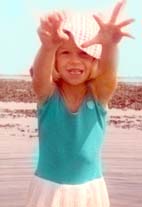 Midyims (top) and Nujigums (below)
Midyims (top) and Nujigums (below) I've been thinking about the different ways we use maps and navigation techniques to get around the wallum and find various plants. Recently I was walking around the backroads of Cooloola National Park with my technology savvy companion who relies on GPS to get around town and bush. You can see contour marks, roads, compass and where you have been on this gadget so it makes it quite difficult to get lost unless the batteries run out. Luddism makes me triumphant when this happens! I am wary of such technology, preferring an old style paper map, a fairly good sense of direction, some visible landmarks and a 'solar derived' notion of north. But all these devices, new and old, while setting out to 'close the distance' also seem to somehow put a distance between person and landscape so that you can pass through a place without knowing or feeling or being there.
Shannon and I were at Peel Island last month walking through cypress and eucalypt forest with the National Parks ranger looking for a narrow slither of wallum . Peel is quite flat and I lost my bearings soon after leaving the road. As Shannon related, we were being carefully guided so we found the open wallum fairly directly. We made our observations, took our photos and the snakes kindly let us though. Then we took a 'short-cut' back to the road through a dense and high fern, peat and melaleuca forest which required us to push through with our whole bodies. Evidently the forest had regenerated after fire more quickly than our guide anticipated. For a brief moment we had that feeling of being lost. Everything looked the same. Forest stretched as far as we could see in all directions and every few steps the false floor of the peat layer gave way and we fell through to the true ground like Alice in Wonderland. But we did feel that we were really 'there', wherever 'there' was.
This experience led me to ask Shane Coghill, traditional owner how he would navigate when landmarks are not easy to see. He related how pathways to significant sites are told in stories and it may be years before this knowledge is called upon. And when it is, there is considerable pressure to find the site, with knowledge concentrated in a chosen few to keep the sites safe. In what would probably sound like mysterious metaphor to me, the story might describe the patches of midyims and nujigum (pronounced midge-ims and nudge-ims) and their delicious berries along the way. Knowing the plants is important and the seasons too, as deadly snakes are associated with these species at certain times of the year. Children are warned off the delicious fruiting midyims (now fruiting) for fear of the death adder which hides under foliage, tempting berry-eating wrens with a protein hit by wiggling its tiny worm-like tail. And the tell-tale blue staining on a child's mouth will alert a watchful parent if they have been spending too long feasting on Nujigums where red bellied black snakes are found.
So this awareness, with an intimate understanding and embodiment of the spirit of the land makes it possible to find places without paper maps or high-end GPS equipment. That there is more going on than the graphical representations of contour lines is both fascinating and mysterious to me and presents a new way of being here/there.
It is this kind of mapping and the creative journey that I think of when rolling the words "Swamp Cartography" around in my head. I hope that the jewellery, ceramics and glass works that we create will have the immediacy of notes taken along the way.

